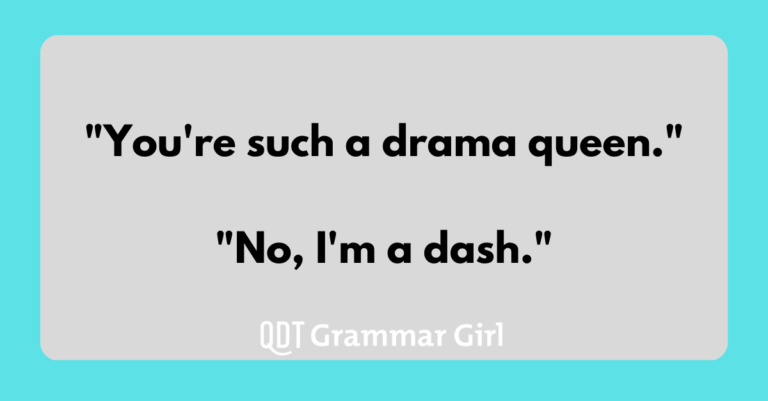Last week when I was speaking at the Field’s End Writers Conference on Bainbridge Island, someone in the audience asked about dashes. When should she use a dash and how is it different from a colon ?
Dashes and Drama
The difference between a colon and a dash is pretty subtle: they can both serve to introduce a related element after the sentence, but a dash is a stronger and more informal mark than a colon. Think of a colon as part of the sentence that just ambles along. “Squiggly has two hobbies [and, now I’m going to tell you what they are, colon] cooking and bothering Aardvark.”
A colon informs readers that something more is coming along. The words after a colon define or clarify what came before the colon. The two hobbies before the colon are defined after the colon as cooking and bothering Aardvark.
A dash also introduces extra material, but, well, a dash is quite a dramatic punctuation mark. A dashing young man is certainly not an ordinary young man, and if you’re dashing off to the store, you’re not just going to the store, you’re going in a flurry.
A dash interrupts the flow of the sentence and tells the reader to get ready for some important or dramatic statement. If you added a dash to the “hobbies” sentence it would conceptually read something like this: “Squiggly has two hobbies [wait for it; wait for it; dash] cooking and bothering Aardvark.” Wow!
Normally, you don’t want to follow a dash with something boring or mundane, so given that there isn’t really anything exciting about Squiggly’s hobbies, a dash may not be the best choice here. It would be a better choice if that sentence were part of a mystery novel where Aardvark has been attacked with chocolate pudding, and the police were investigating Squiggly’s involvement. Then it could be a dramatic announcement that Squiggly’s two hobbies are cooking and bothering Aardvark, and a dash would make more sense.
Dashes, Not Hyphens
And here’s a very important rule about dashes: never, never, never use a hyphen in place of a dash. A hyphen is not a junior dash; it has its own completely separate use that I’ll talk about some other time, but I can’t talk about dashes without telling you not to use hyphens when you should use dashes. It’s a common error.
If for some reason you can’t insert the dash symbol, use two hyphens right next to each other: hyphen hyphen [–]. If you type two hyphens without any spaces on either side, most word processors will automatically convert them to an em dash. If you put spaces on both sides of the two hyphens, word processors will often automatically convert them to an en dash.
Em Dashes and En Dashes
Huh? What are these em dashes and en dashes of which I speak? An em dash is longer than an en dash. Those may seem like strange names, but they make sense when you realize that traditionally the em dash is as long as the typeset capital letter M and the en dash is as long as the typeset capital letter N.
The em dash is the kind of dash I was talking about before; it is the kind of dash you use in a sentence (1). When people say, “Use a dash,” they almost always mean the em dash.
The en dash is used much less frequently and usually only to indicate a range of inclusive numbers. You would use an en dash to write something like Squiggly will be on vacation December 2 to December 9, where the to between the dates is an en dash and indicates that Squiggly will not be in the office starting the 2nd of December and will return after the 9th of December (because an en dash indicates that the numbers are inclusive of the two dates).
Whether you are using the longer em dash in a sentence or the shorter en dash to indicate an inclusive range, there are no spaces between the dash and the words around it. This is actually a style choice, so you should consult a style guide if your company or teacher has one, but I recommend using no spaces.
References
- 1.The Chicago Manual of Style. Fourteenth edition. Chicago: University of Chicago Press, 1993, p. 5, p. 107.




